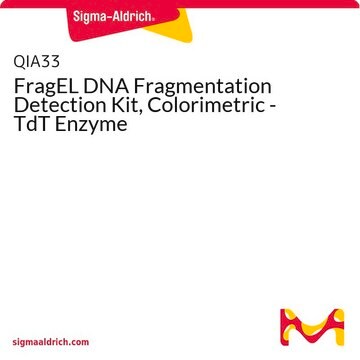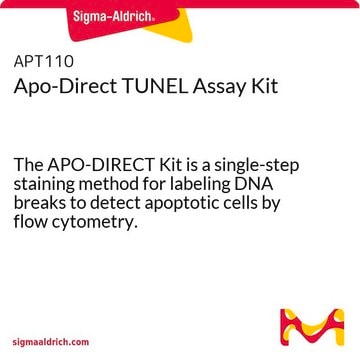11835246001
Roche
Apoptotic DNA-Ladder Kit
Synonym(s):
DNA ladder
About This Item
Recommended Products
usage
sufficient for ≤20 tests
manufacturer/tradename
Roche
storage temp.
20-25°C
General description
The study of cell death involves characterizing mortality as apoptotic or necrotic. Apoptosis can be characterized by:
- Prelytic, non-random fragmentation of DNA (“ladder” pattern after agarose-gel electrophoresis)1
- Formation of membrane-bound vesicles (or “apoptotic bodies”)
- Cell shrinkage due to a concentration of cytoplasm
Similarly, necrosis (or physiological cell death) is characterized by
- Random digestion of DNA (DNA smear after agarose-gel electrophoresis)
- Swollen organelles and cells, resulting from loss of membrane integrity and cell lysis
- Postlytic DNA fragmentation
As these differences indicate, the classification of cell death can be accomplished through observing cell morphology, or less subjectively, by analyzing genomic DNA. Resolving the DNA on a gel provides a quick and documentable form of data to differentiate between apoptosis and necrosis.
Specificity
Application
Packaging
Principle
Preparation Note
Preparation of Working Solutions
- Add 80 ml ethanol, analysis grade, to Washing Buffer
- Dissolve Positive Control (violet cap) in 400 μl Binding/Lysis Buffer and mix immediately.
- Incubate for 10 minutes at 15 to 25 °C.
EDTA solution (0.5 M)
Dissolve 18.6 g EDTA in 80 ml double dist. water and stir. Adjust pH 8.0 ± 0.1 with 1 M NaOH. EDTA solubilizes at alkaline pH only. After solubilization fill up to 100 ml with double dist. water.
TBE-Buffer
Dissolve 5.4 g Tris, 2.8 g Boric acid in 800 ml double dist. water and add 2 ml
of 0.5 M EDTA solution . Stir until dissolved, final pH 8.0 ± 0.1. Fill up to 1 liter with double dist. water.
Ethidium bromide stock solution
Dissolve 50 mg ethidium bromide in 5 ml double dist. water (ethidium bromide is a mutagen and potential carcinogen; gloves should be worn and care should be taken when handling ethidium bromide solutions).
Alternatively SYBR Green I Nucleic Acid Gel Stain can be used instead of Ethidium bromide.
Loading Buffer (10x)
Dissolve 0.1 g sodium dodecyl sulfate, 25 mg Bromophenol Blue in 7 ml double dist. water and add 3 ml glycerol
Storage conditions (working solution): The positive control can be used for 14 days after preparation, when storing the isolated control DNA at -15 to -25 °C.
Other Notes
Legal Information
Kit Components Only
- Binding/Lysis Buffer
- Washing Buffer
- Elution Buffer
- Polypropylene Tubes, contain two layers of glass fiber fleece and can hold up to 700 μl sample volume
- Polypropylene Collection Tubes
- Control Apoptotic U937 Cells, lyophilized
Signal Word
Danger
Hazard Statements
Precautionary Statements
Hazard Classifications
Acute Tox. 4 Oral - Aquatic Chronic 3 - Eye Dam. 1 - Skin Irrit. 2
Storage Class Code
12 - Non Combustible Liquids
WGK
WGK 2
Flash Point(F)
does not flash
Flash Point(C)
does not flash
Certificates of Analysis (COA)
Search for Certificates of Analysis (COA) by entering the products Lot/Batch Number. Lot and Batch Numbers can be found on a product’s label following the words ‘Lot’ or ‘Batch’.
Already Own This Product?
Find documentation for the products that you have recently purchased in the Document Library.
Customers Also Viewed
Articles
Cellular apoptosis assays to detect programmed cell death using Annexin V, Caspase and TUNEL DNA fragmentation assays.
Our team of scientists has experience in all areas of research including Life Science, Material Science, Chemical Synthesis, Chromatography, Analytical and many others.
Contact Technical Service












